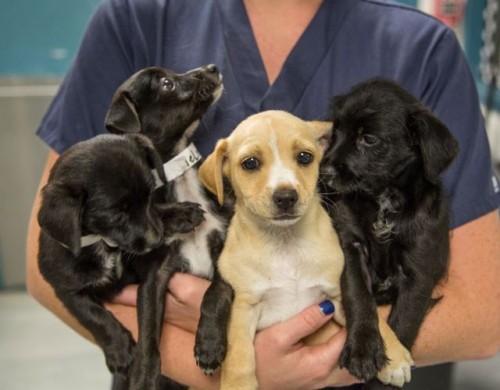How to Bring an Adopted Dog Home
1Prepare your home beforehand. Remove any items he could choke on and put up any electrical wires. Change is stressful, and behavior problems may arise while he adjusts to his new environment. Set up a crate or a safe room where he can stay when you are not home to watch him. Place his food and water bowls in the area so he sees it as his.
2Walk him around your property first when you bring him home, keeping him on the leash so he doesn’t wander off. Give him plenty of time to investigate every inch of the yard if he wants to, and lead him to all areas he will use. Walk him long enough for him to empty his bladder as well so he will be less likely to mark indoors.
3Take him inside when he is done exploring the yard. Keep him on the leash as he explores his new home. Walk him from room to room, allowing him to stop and explore as much as he wants. Do not rush this process. If he attempts to mark his new territory, stop him by saying “no” loudly and take him outside to urinate.
4Show him his crate or area where his food and water bowls are. Fill both bowls and allow him to eat or drink if he wants. Remove his leash and allow him to roam freely, but watch him carefully. Take him outdoors to potty every two hours. Shower him with affection and hand out treats when he potties in the right place or behaves properly.
5Continue keeping him under supervision for several weeks while he adjusts. Once he is comfortable in his new home and has learned what is acceptable, he can be left to roam freely if that is what you prefer.
Parvo Outbreak Plagues Los Angeles County
In a dog health crisis that hits near to home for this dog writer, I encourage everyone to read this and pass it along to any dog owner’s and lovers you know in the LA area.

Vaccination Timelines for Dogs and Puppies>>
Although the disease is most commonly seen in young puppies, Parvovirus can affect unvaccinated dogs of any age. All county residents are urged to keep puppies and dogs safe by not letting them outside of your fenced yard until they have received their vaccinations and are protected from the virus.
“In springtime, you get a lot of newborns during that time and there’s an increase in susceptible hosts,” Maria Sabio-Solacito, the head veterinarian for animal care and control tells LATimes.
Parvo does not affect humans, but is highly contagious and deadly among dogs. The resilient virus is shed through bodily fluids can survive for months or years on surfaces. It is easily spread by humans with their hands and feet.
Symptoms often begin with a high fever, lethargy, depression and loss of appetite. If the disease is left untreated it can cause severe gastrointestinal distress, including vomiting and bloody diarrhea. In many cases, dehydration, shock, or death can follow.
If your puppy or dog is exhibiting any of the symptoms of Parvo, veterinary treatment is required immediately.
Help prevent the spread of Parvo:
Keep infected dogs isolated from all other dogs for at least one month after recovering cleaning up your dog’s stool and keep it away from other pets
Use 1 part chlorine bleach to 30 parts hot water disinfectant on food and water bowls, bedding, and on outdoor areas such as patios.
If your pet is not vaccinated, do not take it to places where interaction with other dogs is likely.
Parvo vaccinations can be done by your vet and is also offered by many mobile vaccination programs.





